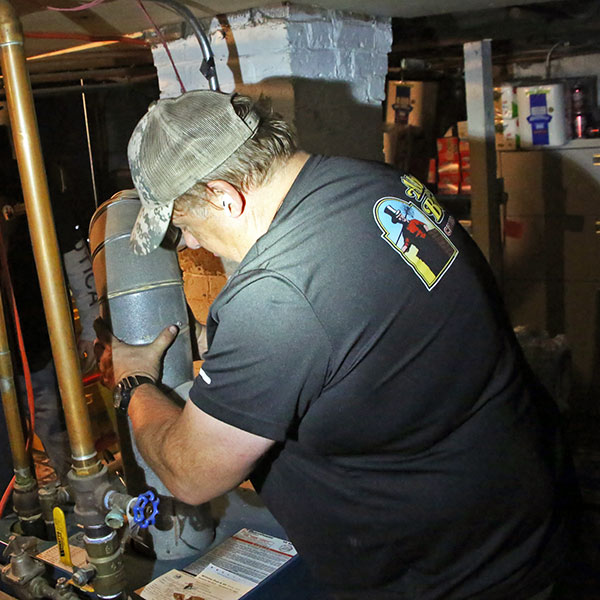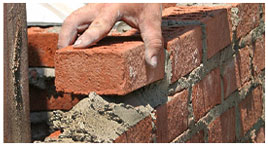Furnace Flue Blocked & Leaking Carbon-Monoxide?
 How is your furnace flue holding up? Our experience in the Northeast has opened our eyes to the failing furnace flues in our area. These flues vents can be leaking dangerous carbon-monoxide into your home and you may not even be aware of it.
How is your furnace flue holding up? Our experience in the Northeast has opened our eyes to the failing furnace flues in our area. These flues vents can be leaking dangerous carbon-monoxide into your home and you may not even be aware of it.
Currently most furnace flues are made up of terra-cotta clay flue tile and have many problems that can occur over the 20 to 80 years that they may have been venting furnaces, fireplaces and water heaters.
There can be cracking, chipping, spalling of the clay tiles, and ultimately there comes the final collapse. As a homeowner, you really don’t want to get to that point! Collapsing tiles can cause a blockage in your flue and lead to CO2 gases entering your living space… and that is EXTREMELY dangerous.
The State of Massachusetts requires you to have a working CO2 detector in your home in more than one location. Don’t let your flue lining collapse and block these dangerous gases, causing them to enter your home instead of being vented properly up the chimney.
Let Above & Beyond Chimney Service come to clean and evaluate your chimney and furnace flue with their state-of-the-art video camera inspection tools. We can show you (on video and with photos) what is happening inside your furnace venting system. Allow to do this and then we will follow up with our recommendations for the best repair solutions (if we find any problems).
Can You Draft Your Furnace through Your Chimney?
If you’re wondering about whether or not you can attach your furnace venting to your existing masonry chimney, the answer is possibly yes, but certain considerations need to be made beforehand.
The first consideration is who will do the work. It’s not advisable for the average homeowner to undertake this type of project. Even with some so-called “helpful” information you may find online, venting a furnace through a masonry chimney is not a job for untrained individuals. Even HVAC or Oil Companies that install furnaces may not be the best choice when it comes to the venting requirements. In fact many of these companies recommend that you call us to check the venting.
 Today’s furnaces are not ideal for chimney venting
Today’s furnaces are not ideal for chimney venting
Thirty years ago and earlier, it was common to vent a furnace through a clay-tiled chimney flue. Furnaces then ran at about 60% efficiency. This, along with certain components in the system, minimized condensation inside the flues of both internal and external chimneys.
Today’s furnaces typically operate at either 80% or 90% efficiency, which ends up adding excess condensation during the drafting process. This is particularly true with 80%-efficiency furnaces.
High levels of condensation along with acidic flue gases can eventually cause serious damage to a clay tile chimney liner. One solution may be to retrofit your chimney with a more durable stainless steel chimney liner.
Furnaces that run at 90% efficiency should never be vented through a standard chimney, whether it’s an interior chimney or an exterior chimney.
Interior vs exterior chimneys
The air temperature within a chimney flue as furnace venting starts is important. Exterior chimneys, which jut out from a wall, have three sides that are in direct contact with cold outside air. The colder the air inside the flue, the more condensation that will occur during drafting. This applies not only to furnaces but also to fireplaces.
Interior chimneys aren’t as cold as exterior chimneys and are more suitable for venting a furnace, but certain factors can affect this including the height of the chimney, the area of space within the flue liner and the BTU output of the furnace.
Backdrafts of poisonous gases

Aside from damage to a clay tile chimney liner, furnace venting through a standard chimney also can lead to a much more serious problem: the backdraft into the home of carbon monoxide and other harmful gases.
When gas or wood burns, carbon monoxide is created and must be vented efficiently to go up the flue and out into the outside air. When an appliance (furnace or fireplace) is not able to draft properly, carbon monoxide can spill over into crawl spaces or rooms and put people’s health at risk.
The unique danger of carbon monoxide is that it can’t be seen or smelled – meaning, it can’t be detected by people.
Safety first
Before making any alterations to your furnace’s vent system, get in touch with a heating and A/C contractor or a CSIA-certified furnace vent technician. These professionals can advise you on the best way to accomplish the project, and they can provide other options if connecting to an existing chimney isn’t feasible.
No matter how your furnace vents, the system needs regular cleaning. Furnace venting doesn’t accumulate creosote like chimney flues connected to wood-burning fireplaces, but it is subject to particulate buildup that needs to be removed.
Additionally, furnaces and their vent system need regular inspections in order to spot early signs of trouble and get repairs made quickly.
Above & Beyond Chimney Service of Dedham, MA, provides CSIA-certified cleaning and inspection of all types of furnace and fireplace venting systems. Let us take a look at your system before you modify it. Speak with a venting expert today at (781) 383-0415.





